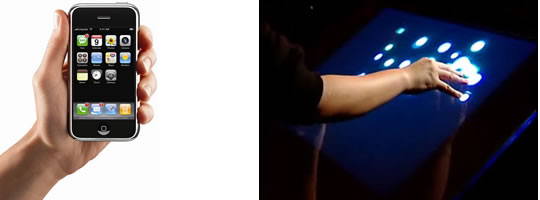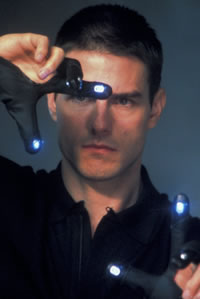Apple Multi-Touch and Han’s Multi-Touch

Since the iPhone announcement at MacWorld some interest has developed in the similarity between Jeff Han’s multi-touch demonstration and Apple’s multi-touch. They both sense multiple fingers touches and they both demonstrated the “pinch” zoom gesture. However, there are some pretty fundamental differences in the hardware driving the two multi-touch interfaces. Read on for a more on this….

The biggest difference between Han’s multi-touch and Apple multi-touch may boil down to what Han described as a “low-cost” implementation compared to Apple’s “a lot of custom silicone.” Han’s multi-touch display, much like the Microsoft Touchlight, uses cameras to see the positions of fingers on the screen and a projector to display the image. Han’s multi-touch sense is done through “Frustrated Total Internal Reflection” which is a very complicated way of saying that lights are mounted between two transparent layers in such a way that when a finger comes in contact with the top layer it appears to glow. The glowing enables the camera to see the positions of the fingers more easily and accurately, just like the gloves with lights of the fingertips worn by Tom Cruise in Minority Report.
This is certainly a great low cost solution but with this hardware implementation it’s difficult to miniaturize. After all, the camera must be far enough from the screen to see it all, and the projector must be far enough to project an image onto it. So while Han’s software implementation is clearly excellent, the hardware makes it impossible for it to be used in any kind of portable computing application. And, quite frankly, this is probably the most important implementation of such an interface.
While I won’t claim to understand Apple’s multi-touch display, it seems to use a multi-layered version of conventional touch screen technology which makes it able to detect multiple touch locations. However, in the Apple demonstrations only two touch locations were shown, so it’s very unclear if it can support more.
Lawsuits?
Steve Jobs made a point of saying that Apple had filed for over “200 patents” and that they “intend to protect them.”
However, Apple suing a researcher that hasn’t released a product seems extremely unlikely, even if the research does resemble any of Apple's intellectual property.
However, the Microsoft Touchlight is a VERY different story. As you might recall, the Microsoft Touchlight multi-touch display also uses the “pinch” zoom gesture. And Microsoft along with a company called EON is releasing the Touchlight.